Introduction
Thinking about getting your first fish tank? A freshwater aquarium setup is a fun hobby that brings a tiny water world right into your home! I’ve been there too, and I can tell you there’s nothing like watching colorful fish swim around in a tank you set up yourself. In this guide, I’ll walk you through all the steps to make a happy home for your future fish friends, from picking out your first tank to keeping your underwater pals healthy and happy.
Hey there! Some links on this page are affiliate links which means that, if you choose to make a purchase, I may earn a small commission at no extra cost to you. I greatly appreciate your support.
Table of Contents
Why Choose a Freshwater Aquarium Setup?
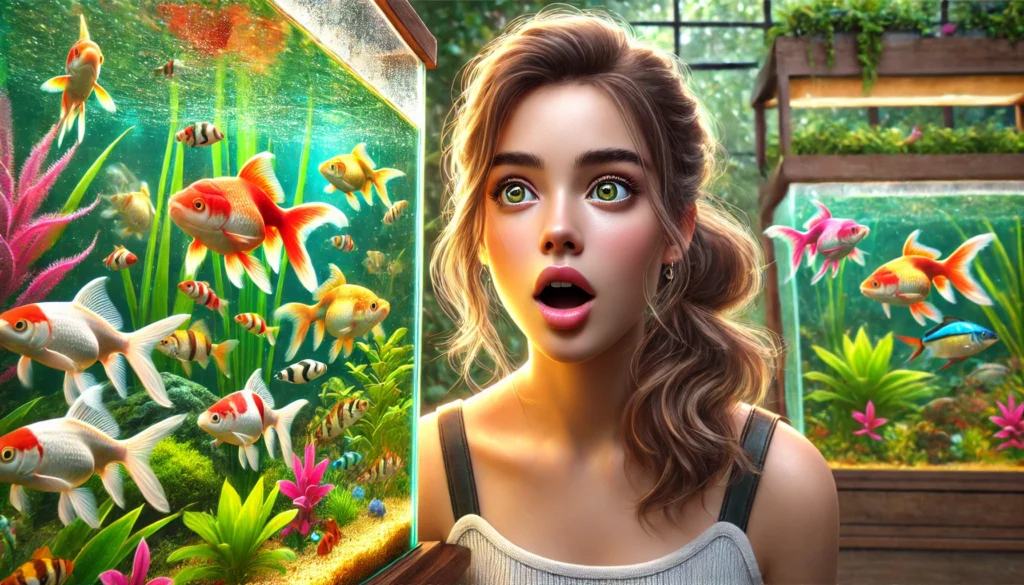
A freshwater aquarium setup is great for beginners because it forgives small mistakes (we all make them when starting out!), costs less than saltwater tanks, and gives you lots of pretty fish to pick from. I remember when I got my first tank – I was so worried about doing everything perfect, but freshwater fish are pretty tough! Your freshwater fish tank setup can become the coolest thing in your house, a real eye-catcher when friends come over.
It’s also a wonderful way to teach kids about caring for pets and the water cycle. Plus, after a long, stressful day, just sitting in front of your tank watching your fish swim peacefully through the water can wash your stress away like magic! There’s a reason doctors put fish tanks in waiting rooms – they really do help calm your mind and lower your blood pressure!
Planning Your Freshwater Aquarium Setup
Before buying anything, you need to think ahead for a happy, healthy freshwater aquarium setup. Good planning makes all the difference!
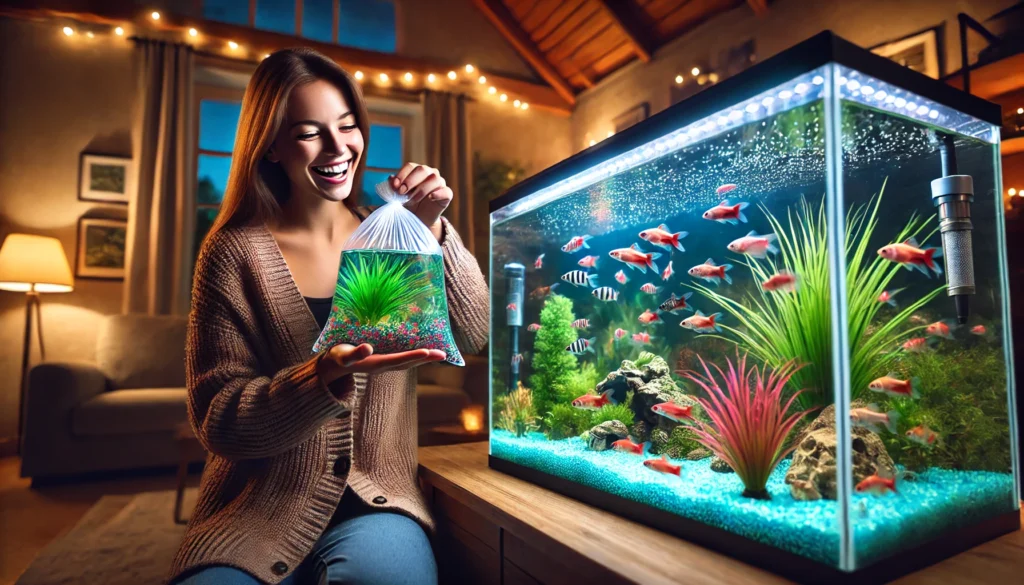
Choosing the Right Tank Size
When starting your freshwater fish tank setup, remember that bigger tanks are actually easier for beginners. Larger tanks (20 gallons or more) keep the water more stable, which makes your freshwater aquarium setup much simpler to take care of. Many new fish keepers make the mistake of getting tanks that are too small, which means fewer fish options and water that gets dirty faster.
Think carefully about where your tank will go:
- Pick a flat, strong surface that can hold all that weight (remember, water is heavy – about 10 pounds for each gallon!)
- Stay away from windows and direct sunlight, or you’ll be fighting green algae all the time
- Keep your tank away from heaters and air conditioners that blow hot or cold air
- Make sure you have power outlets nearby for all your equipment
Essential Equipment for Your Freshwater Aquarium Setup
To create a happy home for your fish, your freshwater aquarium setup needs several important things:
Tank Filtration System
The most important part of your freshwater aquarium setup is definitely your tank filtration system. Good filters work in three different ways to keep your water clean:
- Mechanical: This part catches and traps all the yucky bits, fish poop, uneaten food, and other stuff floating in the water
- Chemical: This helps remove invisible things that can harm your fish, like chlorine or medications
- Biological: This is where friendly bacteria live that change dangerous ammonia (from fish waste) into much safer stuff
If you’re just getting started, hang-on-back filters or sponge filters are perfect choices for your freshwater fish tank setup. They don’t cost too much, they’re super easy to use, and they do a great job keeping your water clean and your fish happy. The filter is like the lungs of your tank, so picking a good one makes your life as a fish keeper much easier!
Heater for Aquarium
Did you know most tropical fish need water that stays between 75-80°F all the time? That’s why a good heater is a must-have for your freshwater aquarium setup! Pick a heater that gives about 5 watts for each gallon of water in your tank. Here’s a friendly tip: always use a separate thermometer to check the real temperature – don’t just trust the heater’s settings!
Aquarium Lighting Setup
Good lighting does several important jobs in your freshwater aquarium setup:
- It makes your fish’s beautiful colors really pop!
- It helps your live plants grow strong and healthy
- It creates a natural day/night pattern that keeps your fish happy
For your first freshwater aquarium setup, LED lights are a fantastic choice – they don’t use much electricity and they last a long time!
Fish Tank Substrate
The stuff you put on the bottom of your tank (we call it substrate) is a big deal in your freshwater aquarium setup. You’ve got some neat options:
- Gravel: Super easy to clean and comes in fun colors to match your style
- Sand: Looks really natural and makes bottom-dwelling fish feel right at home
- Special plant substrates: Perfect if you want to grow live plants in your tank
Just think about what kind of freshwater aquarium setup you’re dreaming of and which fish you want to keep when picking your substrate!
Aquarium Decorations
Decorations aren’t just about making your tank look cool – they give your fish places to hide when they’re feeling shy! When shopping for your freshwater aquarium setup, look for:
- Items with smooth edges (nothing that could hurt your fishy friends!)
- Materials made specially for aquariums that won’t leak harmful stuff
- Fun things like caves, driftwood, and rock formations
Adding live plants to your freshwater aquarium setup is an awesome idea too – they help clean the water by soaking up waste and they put oxygen in the water!
Also Read: Noiseless Aquarium Air Pump Guide: Best 5 Noiseless Options.
Setting Up Your Freshwater Fish Tank Setup
Now let’s go through the step-by-step process of assembling your freshwater aquarium setup.

- Prepare the Tank: Clean your new tank using only water—never soap or household cleaners. These chemicals can hurt your fish even in tiny amounts! Put your tank where you want it to stay before adding water. Trust me, you won’t be able to move it once it’s full—water is super heavy!
- Install the Substrat: Give your fish tank substrate (that’s the gravel or sand for the bottom) a good rinse to wash away all the dust. Then pour it into your tank, making it a bit higher at the back. This little slope looks nicer and makes your freshwater aquarium setup more natural-looking.
- Add Decorations and Plant: Pop in your aquarium decorations and plants while the tank is still dry. It’s way easier to arrange everything now rather than trying to do it underwater! This is where you create the cozy home your fish will love in your freshwater aquarium setup.
- Install Equipmen: Time for the tech stuff! Hook up your tank filtration system, heater for aquarium, and aquarium lighting setup. Just follow the instructions that came with them. Put the heater near where the filter pushes out water—this helps spread the warmth all around your freshwater aquarium setup.
- Fill With Wate: Now for the water! Pour it in slowly over a plate to keep from messing up your nicely arranged substrate. This little trick makes a huge difference for your freshwater aquarium setup. Fill it up to about an inch from the top rim.
- Add Aquarium Water Conditione: Tap water has chlorine and other stuff that’s fine for us but terrible for fish. An aquarium water conditioner is a must-have for your freshwater aquarium setup—it gets rid of those harmful chemicals right away. Just use the amount it says on the bottle.
Cycling a Freshwater Tank: The Critical First Step
Before adding any fish, cycling a freshwater tank is a must-do step. This kicks off the nitrogen cycle, which is super important for
keeping your freshwater aquarium setup healthy.

The Aquarium Nitrogen Cycle Explained
The aquarium nitrogen cycle is just a natural process where helpful bacteria change fish waste (ammonia) into stuff that won’t harm your fish:
- Fish waste and leftover food create ammonia (this can hurt fish)
- Friendly bacteria turn ammonia into nitrites (also not good for fish)
- Another type of friendly bacteria changes nitrites into nitrates (much safer)
- Regular water changes get rid of these nitrates
For a brand-new freshwater aquarium setup, this whole cycle usually takes 4-6 weeks to get going.
How to Cycle Your Tank
To start cycling a freshwater tank:
- Put together your tank with all equipment running
- Add something that creates ammonia (fish food, pure ammonia, or using very tough fish in a “fish-in” cycling method)
- Check your water every few days with an aquarium water test kit
- Wait until both ammonia and nitrite levels drop to zero and you see nitrates showing up
- Do a partial water change before you add your fish
Being patient during this time is key to having success with your freshwater aquarium setup in the long run.
Stocking Your Freshwater Aquarium
After cycling a freshwater tank successfully, it’s time for the fun part—bringing home your fish friends!
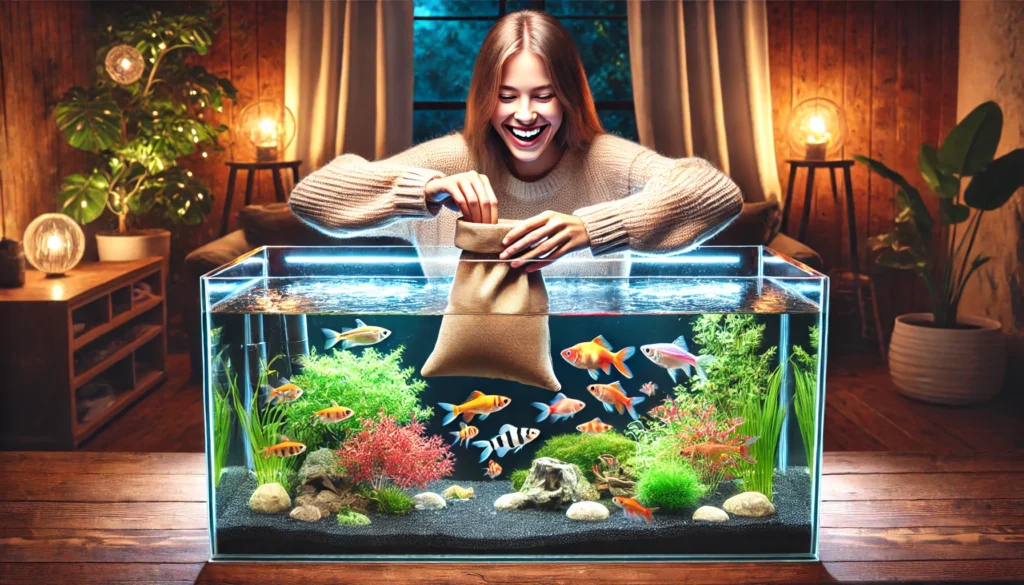
Beginner Fish Species
These tough little swimmers are perfect when you’re just starting your freshwater aquarium setup:
- Guppies: Bright, lively, and get along with everyone
- Tetras: Swim in groups that create beautiful movement
- Platies: Super easy to look after and come in eye-catching colors
- Corydoras catfish: These helpful bottom buddies help keep your tank floor clean
- Betta fish: Stunning and full of character (just remember boys need their own space)
Take some time to learn about each fish type to make sure they’ll be happy in your tank and with your water parameters.
The Fish Acclimation Process
Getting your fish used to their new home properly stops them from getting stressed when adding them to your freshwater aquarium setup:
- Let the closed bag float in your tank for 15-20 minutes so the water temperatures match up
- Open the bag and slowly add small splashes of your tank water every 5 minutes
- After 20-30 minutes, gently scoop the fish into your tank with a net
- Throw away the bag water instead of pouring it into your tank
Stocking Levels
When adding fish to your freshwater aquarium setup, think of this simple rule: about one inch of grown-up fish per gallon of water. But this isn’t set in stone! It really depends on:
- What kind of fish you choose and how much waste they make
- How good your filter is at cleaning the water
- The shape of your tank and how much surface area it has
Start small with just a few fish friends, then slowly add more as your freshwater aquarium setup gets more stable and balanced.
Maintaining Your Freshwater Tank
Taking care of your freshwater tank maintenance isn’t hard—it just needs to be regular, like brushing your teeth!
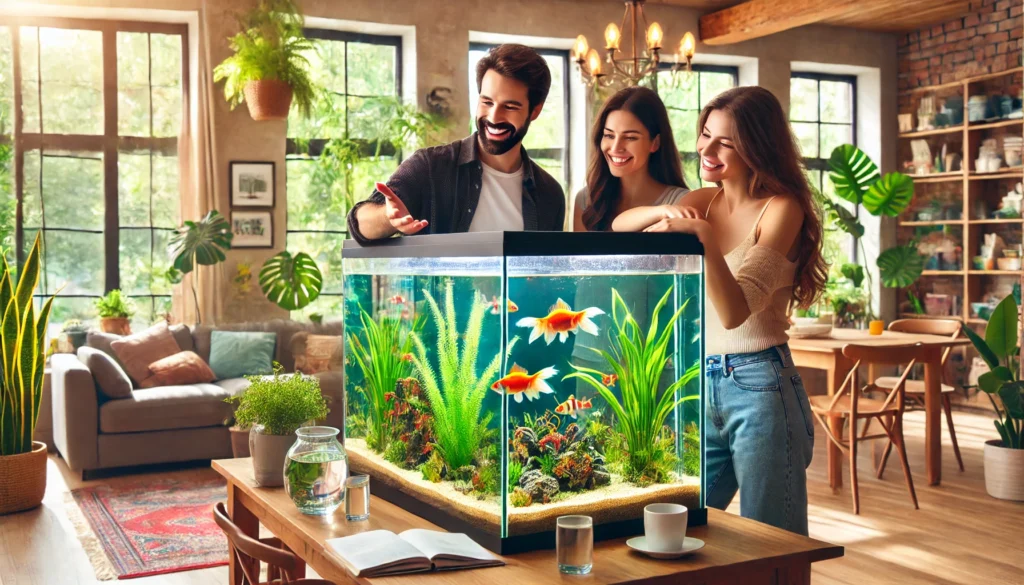
Regular Maintenance Tasks
Here’s what you’ll need to do to keep your tank happy:
- Every week: Check your water with your aquarium water test kit
- Every week: Change about 10-25% of the water (just like changing your bed sheets!)
- Every week: Wipe away any algae from the glass (think of it as window cleaning)
- Every month: Rinse your filter stuff in old tank water (never use tap water—it kills the good bacteria!)
- Every month: Make sure all your tank equipment is clean and working right
- As needed: Trim any overgrown plants and scoop out any yucky stuff at the bottom
Feeding Freshwater Fish
When it’s dinner time for your fish:
- Only give them what they can eat in 2-3 minutes (don’t worry, they won’t starve!)
- Let them skip meals once a week (it’s actually good for their tummies!)
- Mix up their meals with flakes, pellets, and sometimes frozen treats (variety is the spice of life!)
Monitoring Water Parameters
For most fish to be happy in your freshwater aquarium setup, aim for these water conditions:
- Temperature: 75-80°F (24-27°C) (think warm bath water)
- pH: 6.8-7.8 (depends on what fish you have)
- Ammonia: 0 ppm (this is toxic stuff, we want none!)
- Nitrite: 0 ppm (also bad news, keep it at zero)
- Nitrate: below 20 ppm (a little is okay, but not too much)
Use your aquarium water test kit every week to make sure your freshwater aquarium setup stays in this happy zone!
Troubleshooting Common Issues
Even when you try your best with your freshwater aquarium setup, you might run into some bumps along the way. Here’s how to fix those everyday problems that pop up when you’re caring for your underwater friends:
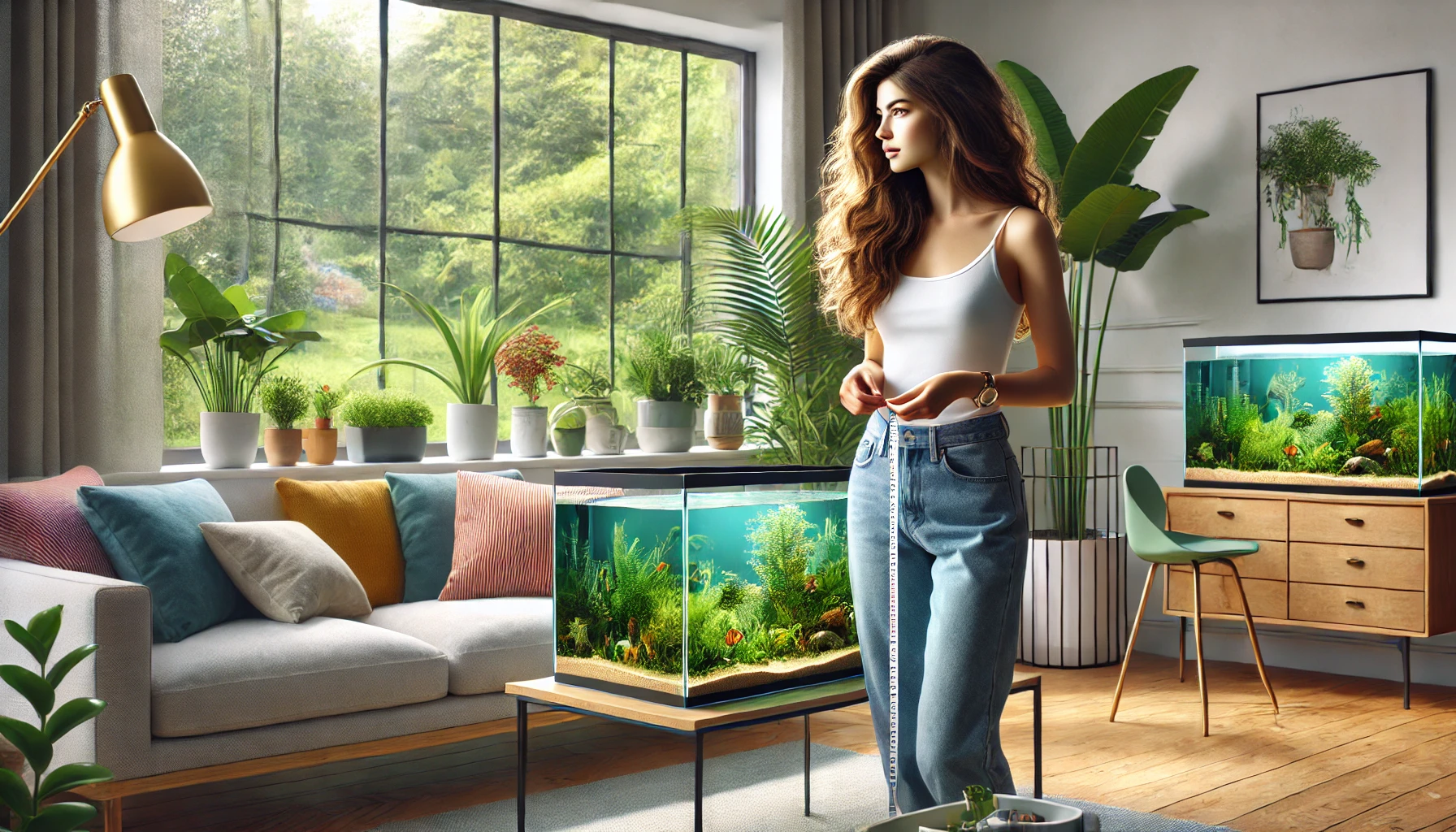
Cloudy Water
- New tank syndrome: Don’t panic! This foggy look often goes away on its own as your tank finishes its cycling process. Your water is just getting used to its new life as a fish home.
- Bacterial bloom: These tiny organisms can make your water look like milk. Try switching out about a quarter of the water with fresh, clean water. Also, check that your filter is running smoothly – it’s working extra hard right now!
- Overfeeding: Fish only need a tiny bit of food – about what they can eat in two minutes. If you see flakes or pellets sitting at the bottom after mealtime, you’re giving too much. Cut back a bit and use a net to scoop out anything they don’t gobble up.
Algae Growth
- Green patches showing up? First, make sure your light isn’t on more than 8 hours each day. Algae loves light just like plants do!
- Keep up with changing some water every week – this removes the nutrients that algae feeds on.
- Nature’s cleanup crew can help! Think about adding some algae-eating fish or snails who love to munch on those green spots.
- Remember that leftover fish food turns into algae fuel, so only feed what your fish can finish quickly.
Fish Health Problems
- Always keep new fish in their own separate tank for about two weeks before they join your main fish family. This stops any sickness from spreading.
- If your fish starts acting strange – maybe swimming funny or not eating – look up their symptoms online or ask at your pet store. Different fish illnesses need different medicines.
- The number one way to keep fish healthy is through good freshwater tank maintenance. Clean water makes happy fish!
Freshwater Aquarium Setup Cost Considerations
When planning your underwater world, the freshwater aquarium setup cost can vary quite a bit depending on how big you go and what quality stuff you choose:
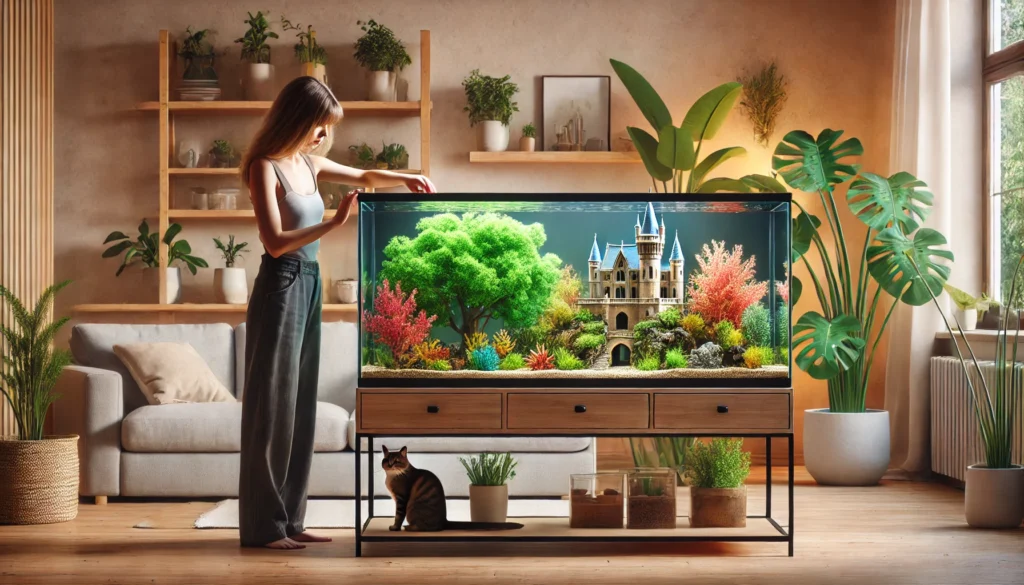
Basic Setup (10-20 gallons)
- Tank and hood: $30-100 (The glass home itself and the lid that keeps jumpy fish safe)
- Filter: $20-40 (This amazing machine keeps water clean by removing yucky stuff)
- Heater: $15-30 (Keeps the water warm and cozy for your fish friends)
- Lights: $20-50 (Helps you see your fish and gives any plants the light they need to grow)
- Substrate and decorations: $30-80 (The pretty rocks or sand on the bottom plus caves and plants for fish to explore)
- Test kit and water conditioner: $30-50 (Tools to make sure your water is safe for fish to live in)
- Initial fish stock: $20-50 (Your first swimming buddies!)
Total freshwater aquarium setup cost: $165-400
While bigger tanks do cost more money to start with, they actually give you more wiggle room when caring for fish. In a larger tank, water stays cleaner longer, and temperature and chemical levels don’t change as quickly. Plus, your fish have more swimming room to stretch their fins and show off their natural behaviors. It’s like giving them a house instead of just a bedroom!
Here are the best product for a fish aquarium
1. SC Aquariums 150 Gallon Starfire Glass Aquarium
Aquarium Tanks
| Feature | Specification |
|---|---|
| Brand Name | SC Aquariums |
| Material | Glass |
| Item Weight | 300 pounds |
| Item Dimensions LxWxH | 60 x 24 x 24 inches |
| Best For | Fish |
| Customer Rating | 4.3 out of 5 stars ⭐ (Not Fixed) |
2. Tetra Aquatic Deluxe Kit 20 Gallons, aquarium With Filter And Heating Lamps
Aquariums & Terrariums
| Feature | Specification |
|---|---|
| Brand Name | Tetra |
| Material | Glass |
| Item Weight | 41.4 pounds |
| Item Dimensions LxWxH | 33.93 x 15.81 x 17.69 inches |
| Best For | Reptiles, Fish |
| Customer Rating | 4.6 out of 5 stars ⭐ (Not Fixed) |
3. API STRESS COAT Aquarium Water Conditioner 5-Gallon Bottle
Aquarium Water Treatments
| Feature | Specification |
|---|---|
| Brand Name | API |
| Item Weight | 1 pounds |
| Best For | algae-eaters, Fishes, mollusks, octopuses, snails, sharks, rays |
| Size | 5-Gallon |
| Style | Aquarium Treatment |
| Customer Rating | 4.8 out of 5 stars ⭐ (Not Fixed) |
4. API Stress Zyme Freshwater and Saltwater Aquarium Cleaning Solution
Aquarium Filtration Systems
| Feature | Specification |
|---|---|
| Brand Name | API |
| Item Weight | 2 pounds |
| Item Dimensions LxWxH | 10 x 10 x 10 inches |
| Best For | Fish |
| Style | Freshwater |
| Customer Rating | 4.7 out of 5 stars ⭐ (Not Fixed) |
5. Fluval FX4 High Performance Canister Aquarium Filter
Aquarium Filters
| Feature | Specification |
|---|---|
| Brand Name | Fluval |
| Best For | Fish |
| Item Weight | 14.1 ounces |
| Item Dimensions LxWxH | 15.6 x 15.6 x 17.7 inches |
| Specific Uses for Product | Indoor |
| Customer Rating | 4.5 out of 5 stars ⭐ (Not Fixed) |
Conclusion – Dive Into the Fun World of Fish Tanks
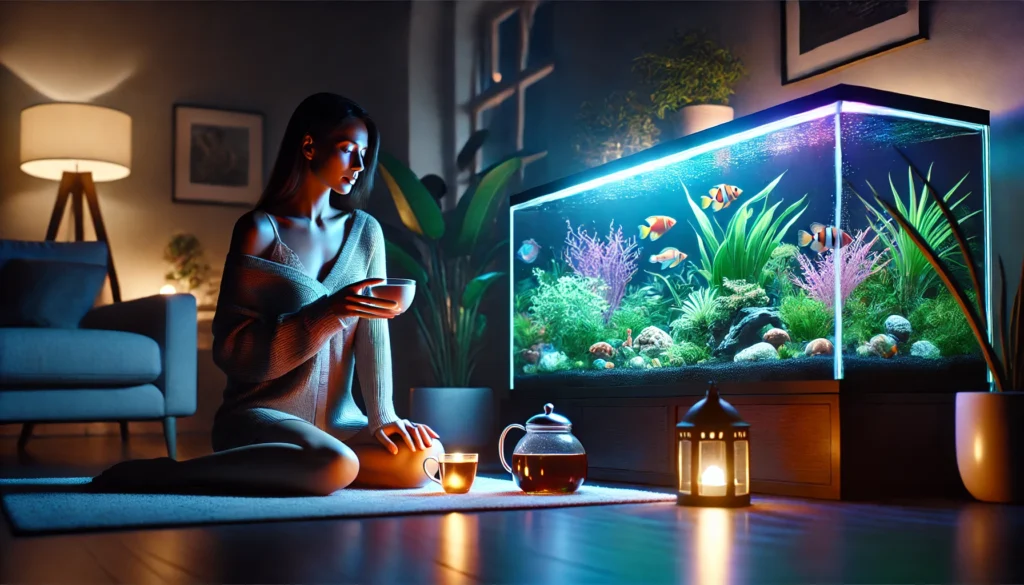
Setting up your first fish tank brings a slice of underwater life right into your home. Watching fish swim can help you relax after a long day, and the tank itself can be a beautiful part of your room that friends and family will love to see.
Getting from empty tank to happy fish home takes some work and care. As you’ve seen in this guide, every part matters—from the filter that keeps the water clean to the fish you pick to live together. When all these pieces work well together, your tank will become a tiny world full of life.
Before you add fish to your new tank, keep these key tips in mind:
- Don’t rush: The biggest mistake new fish keepers make is going too fast. Let your tank cycle fully, add fish a few at a time, and make changes slowly. Being patient will help your fish stay healthy.
- Bigger tanks work better: Starting with a larger tank (20+ gallons) actually makes things easier because the water stays more stable and you have more options for what fish to keep.
- Keep up with tank chores: Regular water tests, changing some water weekly, and checking your equipment aren’t just extra tasks—they’re must-dos. When you do these things on schedule, they don’t take long and they stop big problems.
- Talk to other fish keepers: Think about joining online groups or local fish clubs to meet people who have been keeping fish for years. They can give you tips that fit your exact setup.
- Have fun along the way: Setting up and cycling your tank aren’t just steps to get through but chances to learn about water life. Each part of growing your tank has its own joys and lessons.
With what you’ve learned from this guide and by taking good care of your tank, your fish home will grow into a lively underwater world that brings beauty, wonder, and calm to your home for years to come. Welcome to the wonderful world of fish keeping!
Also Read: Aquarium Pump Guide: Best 5 Picks for Optimal Performance
FAQs About Freshwater Aquarium Setup
How long does it take to cycle a freshwater tank
Cycling a freshwater tank usually takes about 4-6 weeks. You can speed things up a bit with those helpful bacteria products, but you’ll still need to check your water parameters to make sure the cycle is really done
What’s the best tank size for a beginner
A 20-gallon tank is perfect for your first freshwater aquarium setup. The water stays more stable than in tiny tanks, and it won’t take up too much space or empty your wallet
How often should I change the water in my freshwater aquarium
Change about 10-25% of the water once a week as part of your freshwater tank maintenance routine. This helps get rid of nitrates and adds fresh minerals back into the water
Can I use artificial plants in my freshwater aquarium
Absolutely! Fake plants are super easy to care for and still give your fish great hiding spots. Live plants do some extra work by soaking up waste, but they need good lighting and more attention
How many fish can I put in my tank
A good rule of thumb is one inch of grown-up fish per gallon of water, but always look up what your specific fish need. Some fish just need more swimming room than others, even if they’re not that big
How do I know if my fish are healthy
Happy, healthy fish have bright colors, spread-out fins, swim around actively, and love mealtime. Keep an eye out for warning signs like closed-up fins, weird spots, crazy swimming, or skipping meals
What should I do if my fish get sick
First thing, check your water quality. Most fish problems come from water issues. Look up the specific symptoms you see and use the right medicine. Having a separate tank just for treating sick fish can be really helpful
Is a betta fish tank good for beginners
Yes, a betta fish tank can be great for beginners, but make sure it’s at least 5 gallons with proper heating and filtration. Despite what many people think, bettas need more than just a tiny bowl to be happy and healthy
How do I clean my tank without stressing the fish?
Do gentle partial water changes, vacuum the gravel carefully, and clean decorations as needed. Never replace all your filter stuff at once—this keeps your good bacteria colony working properly.

